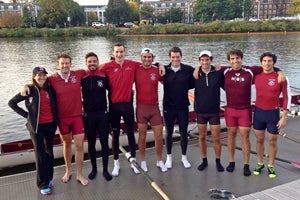The Harvard Law School crew raced in the 49th Head of the Charles Regatta on Oct. 19, competing against 46 other club eights from around the country. Navigating the course in an impressive 16 minutes and 42 seconds, this year’s HLS eight broke the team’s previous course record of 17 minutes 4 seconds—standing since 2008—by more than 20 seconds. The crew beat boats from Chicago and Delaware, as well as local competition from Community Rowing, Inc. The club proudly retained its title as the fastest law school in the regatta.
This team members on this year’s eight boat were Mira Mehta (Coxswain) HBS ’14, Andreas Jaegle HBS ’14, Alexander Simmonds ’16, Andrew Boston HBS ’15, John DiCola HBS ’15, Jonathan Garrity HBS ’15, Maxime Cancre HBS ’14, Robert Greenglass HBS ’14, Carlos Rivera HBS ’15.
The world’s largest two-day rowing event, the 2013 Head of the Charles, attracted more than 7,500 athletes from the around the world and drew close to 400,000 spectators during the weekend. Coming one year after the 2012 Olympics, the event saw the participation of a number of Olympic Medalists including the 2012 gold medalist in the single scull, Mahe Drysdale. Several national team crews were on display, including entries from both the US Men’s and Women’s national teams, testing their skill and strength on the Charles River.
With the benefit of a moderate tailwind, the tenacious HLS crew chased down opponents and held off challengers from behind. Alexander Simmonds ’16, a new recruit to the team who previously rowed as an undergraduate for Columbia University’s varsity heavyweight crew, said: “The boat’s success on the water came directly from every rower’s commitment to each other and to the team as a whole. In a long head race like the Head of the Charles, you have to be able to have complete confidence in the man sitting in front of you, and the man behind. That trust allows the crew to really feed off each other to squeeze out every last bit of speed, and I think that’s what we saw.”
The team’s on the water workouts included sprint and endurance rowing at high stroke ratings, with outings four days a week in the month leading up to the regatta.
